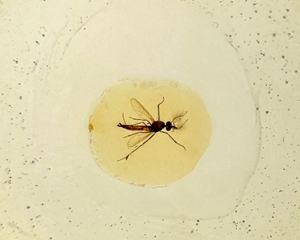Paleontologists have recently uncovered prehistoric mosquitoes in Lebanese amber dating back 125 million years.
最近,古生物学家在黎巴嫩的琥珀中发现了史前蚊子,其历史可追溯到1.25亿年前。
This discovery represents the earliest-known mosquito amber fossil, and introduces a previously undocumented species.
这一发现是已知最早的蚊子琥珀化石,并引入了一个以前没有记载的物种。
The male mosquitoes feature piercing mouthparts, suggesting a potential blood feeding lifestyle.
该雄蚊拥有极具穿透力的口器,表明其可能是以吸血为生。
This finding provides valuable insights into the diversity of ancient insect life during the early Cretaceous Period.
该发现也为了解白垩纪早期古代昆虫的多样性提供了有价值的见解。
In a recent publication in Current Biology, paleontologists revealed a groundbreaking discovery in Lebanese amber dating back 125 million years.
在《当代生物学》杂志上最近发表的一篇文章中,古生物学家透露了一项在黎巴嫩琥珀内的突破性发现,可追溯到1.25亿年前。

Two male ancient mosquitoes were unearthed,
出土的两只古代雄蚊,
pushing the timeline of the earliest mosquito fossils from the late Cretaceous to the early Cretaceous, and introducing a previously unknown species.
将最早的蚊子化石的时间从白垩纪晚期前推到了白垩纪早期,并引入了一种以前未知的物种。
The researchers found that both males had piercing mouthparts, sharp mandibles, and maxillary palps, indicating a probable blood-feeding behavior.
研究人员发现,这两只雄蚊都有尖锐的口器、锋利的下颌骨和上颌触须,表明它们可能具有吸血习性。
This discovery suggests that not only were the earliest female mosquitoes blood-sucking, but under certain conditions, males may have also exhibited hematophagy.
这一发现表明,不仅最早的雌蚊会吸血,在某些条件下,雄蚊也可能表现出噬血行为。
Future research aims to explore the implications of bloodfeeding in Cretaceous male mosquitoes, and understand why contemporary male mosquitoes no longer engage in this behavior.
之后的研究旨在探索白垩纪雄蚊吸血的意义,并了解为何当代雄蚊不再拥有这种习性。



